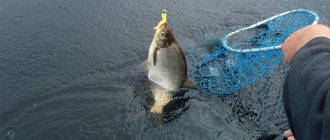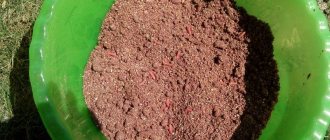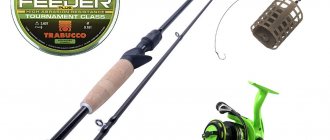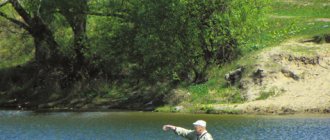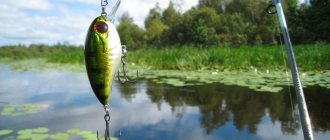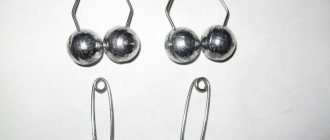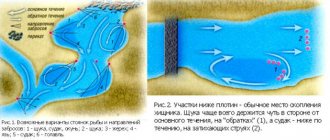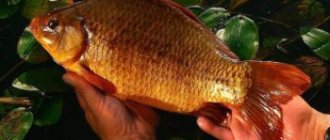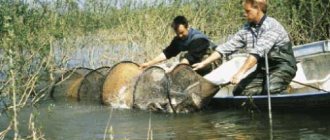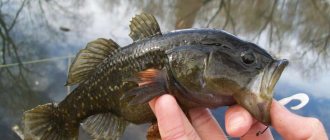Under the current fishing pressure, the most important condition for effective fishing of peaceful fish is bait. At the same time, it was not so much the overall quality of the mixture that became decisive, but rather its advantage in comparison with the compositions of competitors in the reservoir.
It happens that some kind of super improvisation with the composition of components can get ahead of a sports mixture that is consistently winning in many cases. In any case, you should not go to a pond without good bait. We’ll talk about all this in today’s article.
Your own bait for fishing
In order to introduce you to the “bait business”, below I will give the most common methods of preparing fishing bait mixtures, which I use myself.
Methods for preparing bait for fishing from different products at home
For me, bottom or float fishing begins when I come to the kitchen from the grocery store. It is near the stove that the basis for successful fishing is laid, here plans for tomorrow are prepared, based on which fishing bait is made.
What it will be like: soft or hard, dense or crumbly, what components will be present are dictated by the fishing conditions and the object of the hunt, that is, fish. Therefore, standing at the meat grinder or at the stove, I “scroll” in my head all possible scenarios for the development of events on tomorrow’s fishing and “adjust” the prepared food to suit them.
It seems like a simple matter - bait. If you throw something edible into the water, the fish will gather closer to the fishing spot and begin to bite. Maybe in the old days, when there was enough fish, they did this. Today, the situation is different: the number of fish has decreased, and the fish have become wiser and become capricious. She is not now rushing headlong into table scraps and waste from the food industry. Give her high-quality, properly prepared products, and even presented correctly - so our fishermen sweat in the kitchen no worse than their wives and then think through the strategy and tactics of feeding. But the fish still regularly ignores our efforts. And the variety of modern industrial fishing baits and the advertising that accompanies them can generally confuse the fisherman. Through trial and error, I came to three main points that relate to complementary feeding.
Firstly: use only a proven composition and feed according to proven tactics (this does not mean that I always feed with the same bait and always the same: for different fish and different conditions - different mixtures and different tactics).
Secondly: experiment only when proven bait and techniques do not help. I think that thoughtless improvisation with bait is fraught with lack of bite or “eating” on small things, which is no better.
And most importantly: do not trust any “lures” of bait.
crumbling
I use it in both float and bottom bait, naturally not in its pure form. Inexpensive industrial bait is also suitable as a crumbly mixture, the main requirement for which is a stable, but not pungent odor. The mixture may smell like a flavor (vanilla, cinnamon, strawberry, etc.), or it may have a neutral odor, reminiscent of aquarium food. When buying a package of fishing bait, I always sniff to see if it is musty.
Next, I dilute this mixture to increase its quantity and reduce the overly persistent odor. For this I use breadcrumbs, semolina and seeds.
By the way, you can make bait from these components from scratch, which is what I do when I can’t buy a store-bought mixture. I twist the crackers in a meat grinder from pre-dried pieces of loaf.
I have developed a good habit of periodically setting aside a loaf of bread to dry so that I have a reserve supply of crackers. If that doesn't work, you have to use the oven. Along with the breadcrumbs, I also twist the seeds bought at the kiosk (I take the ones I eat myself). Ground seeds have a pleasant, unobtrusive odor, which is great for attracting fish. I try to achieve a crackers-seeds-semolina ratio of 1.5:1:1. I dilute the purchased bait with this mixture approximately 1:1.
Such crumbling performs its main function - it attracts fish with its smell and creates a cloudy suspension, which the fish cannot get enough of, which means its food instincts are excited and it attacks our bait.
Porridge
The smell is a smell, but a fish, especially a large one, also needs to feel the taste of food, otherwise it will quickly figure out the trick and leave, and at best, there will be only a small thing left to peck. This is exactly what porridge is for. In addition, porridge further dilutes the mixture, thereby reducing its cost. And porridge also has its own alluring smell. It also gives fishing bait viscosity and weight, which is often necessary for baiting.
The consistency of the porridge can be viscous or crumbly. The latter, in addition to cereals, includes peas and corn. I usually use crumbly porridge when fishing for crucian carp. I throw it in bulk, or if I need to throw it further away, I mix it with the ground, forming balls.
When river bottom fishing I do not use crumbly porridge, as it is washed out of the feeder too quickly. The main element of such bait is mass starting feeding when catching relatively large fish. Crumbly porridge mixed with a dry mixture attracts fish well, slightly saturates it, preventing it from leaving. This is also an excellent option for attachment.
For porridge I use pearl barley, millet, rice, and have also tried canned corn. But more often I cook a viscous mass (mainly from millet, rice or Hercules). I also mix this with dry food. This makes an excellent fishing bait for the feeder. It is also suitable for float fishing during initial feeding. For float crumbly bait, I mainly use sand or mole soil, mixed with dry food in a 3:1 ratio. For abundant feeding, I don’t use sand; I try to take blacker soil, clay, or swampy peat mass. Having mixed this soil with bait, I make balls (for flow) or cakes (for standing water). I also had to feed them with a mixture of food and sludge. Although such bait did not fly far, it created a strong turbidity, and the fish then bit perfectly.
Additives to bait. Groundbait ingredients table
Nutritional supplements
It’s not enough to lure the fish to the fishing point, you still need to keep it there; for this, various nutritional ingredients are included in the bait.
Flaxseed is an excellent additive for catching bream using various tackles.
Powdered milk and dry cream are protein additives that make our groundbait more nutritious, aromatic and tasty; they also create cloudiness.
Millet is one of the main nutritional supplements for crucian carp fishing; bream and carp also respond well to it.
Vegetable protein PV - 1 makes the bait more sticky, so it is well suited for catching bottom species of fish, you have to be very careful here, as it is easy to overfeed the fish.
Corn grits are a universal nutritional supplement for catching any white fish.
Pearl barley is a nutritional supplement used when fishing for crucian carp and bream, but it also goes well with ide and carp
Peanuts are well-roasted and ground , an excellent bream additive that gives the bait taste and aroma, and perfectly attracts bream, carp and tench.
It is important to remember that the bait must include bait , so if you are going to fish with a worm, bloodworm or maggot, they need to be added to the bait; for amateur fishing, 100-150 grams will be enough for half a day.
Flavoring ingredients
All representatives of the carp family respond well to fishmeal how to catch carp or crucian carp
Seeds - bream reacts very well, but roach is indifferent to them. If you use seeds with the skin on, the skin will act as a loosening agent as it is lighter than water and will break up the ball from the inside, so if you are only targeting larger fish, it is better to use seeds without the skin on it.
ground seeds
Pigeon droppings are an ideal additive for catching roach; the droppings of wild pigeons are of little value, since it is not clear what they ate. You are lucky if you have a friend who feeds pigeons with the same grains that you fish for. The droppings should not have a strong ammonia smell; if there is, the droppings should be poured with boiling water.
Cocoa powder – added in small quantities improves the taste of the bait and creates cloudiness.
Makukha is the cake that remains after squeezing the oil out of seeds, sunflowers or flax. Here you need to be careful in choosing, since old cake will not work, as it becomes harsh and has a weak odor. A good cake should be well pressed, have a slightly shiny, gloss-like surface, and taste like hard halva.
cake
Salt is a great attractor for fish; for them, as for many animals, it is a kind of delicacy. Salted bait ingredients work great in the spring, when there are few minerals in the water due to the influx of melted snow.
Adhesives
They are used when it is necessary to fish in the current and it is necessary that the ball does not disintegrate in the water instantly, but is gradually eroded by the current.
Oatmeal , wheat or corn flour, ground to flour. We need to add it in reasonable quantities so that our bait does not turn into a hard lump, which will then lie like a dead weight in the water
Baby food additionally serves as a protein supplement that improves the nutritional value of groundbait.
Groundbait ingredients table
| Name of bait ingredient | Properties of bait | Contents in bait |
| Molasses | Activates bream biting | No more than 20% |
| Breadcrumbs and fried bread crumbs | The basis of any bait | No more than 30% |
| Honey bread | Works well when catching crucian carp and tench sticks the bait a little | No more than 30% |
| Finely ground red pastoncino | Flavoring and aromatic additive for ide, bream and roach. Capable of holding fish for a long time | No more than 15% |
| Finely ground yellow pastancino | For catching bream | No more than 15% |
| Pigeon droppings | Excellent roach ingredient | No more than 25% |
| Corn cake | Additive for catching large fish, before use it needs to be filled with water for 15 minutes | No more than 15% |
| Sweet crackers | Added to bait in summer | No more than 30% |
| Bread particles of various colors | They serve to visually attract fish and have aromatic flavoring additives. | No more than 10% |
| Red and orange (fluorescent) colored bread | Visually attracts fish, has flavoring additives | No more than 10% |
| Yellow fluorescent bread | A good additive for attracting carp or bream. | No more than 10% |
| PV-1 | Sugar-containing additive is used in river baits | No more than 10% |
| Roasted whole flax and sunflower seeds | An excellent leavening ingredient, has a good aroma and pleasant taste. Increases bait activity | No more than 10% |
| Dried red worms and their meal | Very nutritious additive suitable for catching all types of fish | No more than 10% |
| Peanut | Good flavoring additive that improves fish digestion | No more than 10% |
| Biscuit | Increases the nutritional value of bait and its stickiness, serves to attract various fish | No more than 20% |
| Yellow biscuit | Improves stickiness and nutritional value attracts carp and bream well | No more than 20% |
| Honey sponge cake | A very nutritious additive that attracts a variety of fish species well. Has less stickiness | No more than 20% |
| Nut flour | Recommended for carp and bream fishing. Leaves and improves nutritional value | No more than 20% |
| Roasted hemp | An ideal roach additive. Increases the inertia of bait | No more than 20% |
| Pumpkin seeds | Activates bream biting | No more than 10% |
| Dried silkworm | Increases bait activity. It is good to use when the fish is at half-water. | No more than 10% |
| Crushed corn | Reduces the nutritional value of bait. Loosens and weighs down bait | No more than 10% |
| Corn grits | Increases the nutritional value and inertness of bait | No more than 10% |
Bread
It happens that during the fishing process you realize that the bait lacks viscosity. You can get out of the situation with a crust of bread or a couple of sandwiches. We crumble the bread into the bait, mix it, and good viscosity of the food is ensured. It also happens: the opportunity to go fishing falls out of the blue, and there is no time to cook porridge. In this case, I do this: I buy a loaf of bread and crumble it along with the crumbly mixture at the pond. All that remains is to add the required amount of water. By the way, you need to moisten the food a little at a time, constantly stirring, avoiding oversaturation with water. In my opinion, the bait should be moistened immediately before fishing, using water from a reservoir, and not from the tap. These points apply not only to “bread” bait, but also to other fishing baits.
In conclusion about bread, I will note: if you compare black bread and white bread, then their properties are different. Black is more viscous and has a strong odor, while white creates more turbidity and is better visible on a dark bottom.
Millet
I love this cereal because it is versatile and affordable. The versatility of millet lies in the fact that if you slightly undercook it and dry it thoroughly, it will become crumbly, almost airy. By mixing it with a dry composition, we get the ideal bait for float fishing for roach, small bream, rudd and other “sports” fish. Normally cooked millet, mixed with the same dry composition and crushed to good viscosity, becomes formidable ammunition for feeding artillery.
And its main trump card: it sticks well to itself the crumbly mixture, which creates turbidity, and does not form into lumps, evenly covering the bottom in the place of fishing when feeding. And of course, pearl barley is famous for its wonderful smell that intoxicates fish. In addition, this bait is good for feeding when fishing with a float rod.
Types of bait
Bait can be divided into two types, used for fishing with a float rod and for fishing with a feeder. In my opinion, the differences are not very big, but they still exist.
Feeder bait
First of all, feeder bait is more sticky and should remain in the feeder during casting without spilling out of it. Secondly, since the consumption of bait for a feeder is much less than for a float rod, it should be more concentrated.
Feeder bait is divided into two types - for fishing in currents and for fishing in still water.
In the current composition, more binder has been added, this allows the bait to linger longer in the feeder.
Winter bait
Another type of bait, conditionally winter or for cold water. It usually has less strong odors and smaller packaging.
Bait for float fishing
Bait for float fishing, as well as feeder bait, is divided both according to specific types of fish and according to the size of the fish for which it is intended.
Each type of fish prefers certain combinations of tastes and smells, and their purpose is based on this.
To attract, and subsequently retain, large fish, use large-fraction bait, and for small fish, ground bait ground into dust.
Therefore, when choosing bait, you should not always choose a mixture for large fish, especially if there is not too much of it in the reservoir, this can lead to the opposite result, the fish will get full very quickly and begin to bite very carefully.
Rice
An excellent grain for bait, but due to its rather high price I rarely use it. In principle, rice resembles millet in its properties. But this cereal has one advantage - its color. These white grains are very reminiscent of the same maggot. And on a dark bottom, white rice looks contrasting, allowing the fish to be guided not only by smell, but also by sight when feeding.
So, the choice of cereal depends not only on its properties, but also on the price. I don’t recommend buying cereals of dubious quality; it’s better to take the one you want for your table.
Bite activators.
Liquid bite activators have proven themselves very well . These activators are added when mixing bait and speed up the collection of fish at the feeding site due to their liquid component.
The taste of these activators can be very diverse, from traditional ones such as anise, garlic, to such as tutti fruiti, chocolate, strawberry, etc.
The liquid activator is added to the bait at the time of mixing along with water.
You should not overdo it with this component of the bait, as excessively strong odors can scare away the fish, and it is better to follow the proportions specified in the instructions.
Groundbait color
Many manufacturers produce groundbait in different colors. They come in yellow, red, black and even green. The color of the bait is achieved using food coloring.
This is done due to the fact that in search of food, fish are guided not only by taste buds, but also by vision.
Therefore, if the color of the bottom is known, then it makes sense to choose a contrasting color of the bait; it will be more noticeable to the fish against its background.
At competitions, bait is usually made up of several types, combining in one composition mixtures for different fish and fishing conditions, while adding some components to make the bait more concentrated and attractive specifically for the fish that are in a particular reservoir. But this is required precisely in competitions, when there is a lot of competition; in amateur fishing, this is not necessary, although of course it greatly increases the catch.
Animal components
In most cases, fish value “live” food more highly than plant food. But, alas, not everyone can afford to feed their fish only worms and bloodworms. Therefore, it is worth adding them to our traditional fishing bait, at least whenever possible. I usually add chopped worms and crushed bloodworms. I don’t add moving organisms for the reason that they can disrupt the consistency of the mixture; it’s better if they attract fish with their smell and taste. I almost always add maggot pupae left over from previous fishing trips. If I find a box left on the shore when the smell spreads downstream and active fish are able to rise to the bait. In this situation, you can add a little sand to help wash away the feed. In other cases, I roll fishing bait into clay or earthen balls. For feeder fishing, you also need viscous food, but instead of soil I use porridge or bread. A more complicated situation arises if you need to use crumbly porridge. Usually in such cases the food is thrown upstream so that it sinks to the bottom at the fishing site. I use this technique: I mix crumbly porridge with soil and form balls. When such a ball falls into the water, it will quickly sink, disintegrating further in the water column. As a result, the bottom at the fishing site is covered with a uniform layer of porridge.
All baits for donka fishing
Bottom bait can be called that bait that is able to stay on the bottom in the form of balls, gradually eroded by the current. This method of feeding a catch point is usually used when fishing for carp. The bait is mixed on the shore, rolled into dense and voluminous balls consisting of bait boilies, coastal clay and steamed corn. There is nothing unusual about bait boilies. These are the same boilies used to catch carp, only cut into halves. This is more economical, and most importantly, half boilies hold up better in the current. Such balls are transported by boat to the fishing site and lowered to the bottom upstream from the fishing site. And here the balls are quietly lowered so that they do not break on the water, as is required when fishing with surface bait. Here it is necessary for the balls of bait to lie on the bottom and, as bait, to be lured for two to three days to the place where large carp are caught.
When fishing at shallow depths and away from the shore, sometimes they successfully use lumps consisting of porridge, the set of which can contain the simplest ingredients, as in “salapinka”, that is, pearl barley, millet, corn grits, barley grits, vegetable oil and vanillin .
More cake or slightly toasted and ground seeds are added. Sometimes a very good ingredient and filler is pea puree, slightly undercooked to the point of puree, but the peas must be well boiled. These lump balls are simply thrown by hand to the fishing spot. Heavy bottom bait is thrown over long distances using a slingshot or a cobra-type bait tube. This is if the fishing takes place with a Bolognese or match float rod, where casts reach thirty meters in the presence of heavy equipment and a heavy float.
You can learn about the features of bottom baits and recipes for their preparation in a separate article dedicated to this topic - “Bottom baits”.
Briefly about feeding tactics
I won’t describe how to feed: “a lot at once” or “a little bit at a time” - it all depends on the fishing conditions, the type of fish, the weather, the time of year and day, and many other factors. We will describe all this in other articles, in detail for each type of fishing and fish (look at the top, or in the site menu). I will only share some small tactical tricks. Sometimes a dry crumbly mixture attracts a lot of little things that are difficult to get rid of. In this case, I feed them with one crumbly porridge.
Many people like to fish with a float in a sportive way, regularly throwing crumbly bait. I use this technique: I accompany each cast of the tackle by tossing food. Then I stop throwing food, pausing for about 15 minutes. It is at this time that bites occur from larger fish, which are frightened by the noise of the bait, but then still approach the mud.
